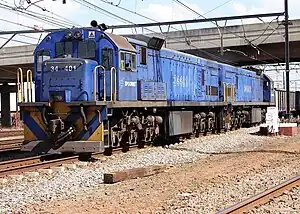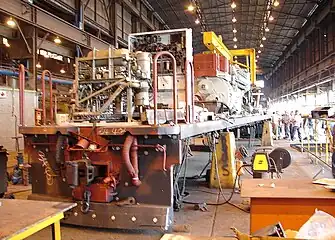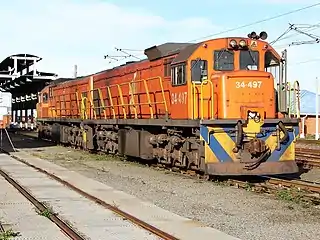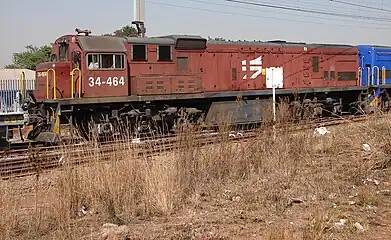| South African Class 34-400 | |||||||||||||||||||||||||||||||||||||||||||||||||||||||||||||||||||||||||||||||
|---|---|---|---|---|---|---|---|---|---|---|---|---|---|---|---|---|---|---|---|---|---|---|---|---|---|---|---|---|---|---|---|---|---|---|---|---|---|---|---|---|---|---|---|---|---|---|---|---|---|---|---|---|---|---|---|---|---|---|---|---|---|---|---|---|---|---|---|---|---|---|---|---|---|---|---|---|---|---|---|
 No. 34-401 at Kaalfontein, Gauteng, 7 October 2009 | |||||||||||||||||||||||||||||||||||||||||||||||||||||||||||||||||||||||||||||||
| |||||||||||||||||||||||||||||||||||||||||||||||||||||||||||||||||||||||||||||||
| |||||||||||||||||||||||||||||||||||||||||||||||||||||||||||||||||||||||||||||||
| |||||||||||||||||||||||||||||||||||||||||||||||||||||||||||||||||||||||||||||||
| |||||||||||||||||||||||||||||||||||||||||||||||||||||||||||||||||||||||||||||||
The South African Railways Class 34-400 of 1973 is a diesel-electric locomotive.
Between April 1973 and November 1974, the South African Railways placed one hundred Class 34-400 General Electric type U26C diesel-electric locomotives in service.[1]
Manufacturer
The Class 34-400 type GE U26C diesel-electric locomotive was designed by General Electric (GE) and built for the South African Railways (SAR) by the South African General Electric-Dorman Long Locomotive Group (SA GE-DL, later Dorbyl). One hundred locomotives were delivered between April 1973 and November 1974, numbered in the range from 34-401 to 34-500.[1][2][3]
Distinguishing features
As built, the GE Classes 34-000, 34-400 and 34-900 locomotives were visually indistinguishable from each other. The Class 34-500 locomotives could be distinguished from the other series by the air conditioning units mounted on their cab roofs and initially, when it was still a feature unique to them, by their running board mounted handrails. At some stage during the mid-1980s, all Class 34-000, 34-400 and 34-500 locomotives had saddle filters installed across the long hood, mounted just to the rear of the screens behind the cab on the sides. Since then, Class 34-900 locomotives could be distinguished from the older models by the absence of the saddle filter.[4][5][6]
Modifications
Fuel capacity
As built, the Class 34-400 had a 5,400-litre (1,200-imperial-gallon) fuel tank and interlinked bogies, while the Class 34-500 was delivered new to Iscor with a 7,000-litre (1,500-imperial-gallon) fuel tank to cope with the lack of en route refuelling points on the Sishen-Saldanha iron ore line. To facilitate the larger fuel tank, the inter-bogie linkage found on all other models had to be omitted on the Class 34-500.[7]
 Standard 5,400 litre fuel tank |
 Enlarged 7,000 litre fuel tank |
To be usable on the iron ore line, Class 34-400 units which ended up working there were modified to a similar fuel capacity. The inter-bogie linkage was removed and the fuel tank was enlarged by changing it from saddle-shaped to rectangular box-shaped. To maintain its lateral balance, a slab of metal was attached to each bogie in place of the removed linkage. In the second picture, the weld lines on the end of the enlarged fuel tank as well as the metal slab at the end of the bogie are visible.
Electronic control system
Beginning in 2010, some units were equipped with electronic fuel injection and GE "Brite Star" control systems. On some of the first locomotives to be so modified, externally visible evidence of the modification is a raised middle portion of the long hood.
Service
South African Railways
GE Class 34-400s work on most mainlines and some branch lines in the central, western, southern and southeastern parts of the country. On the busy line from Krugersdorp via Zeerust to Mafeking, the Class 34-400 became the standard motive power.[8][9]
Some eventually joined the Class 34-500 on the 861-kilometre long (535-mile) Sishen-Saldanha iron ore line, to haul export ore from the open cast iron mines at Sishen near Kathu in the Northern Cape to the harbour at Saldanha in the Western Cape. Here they ran consisted to electric locomotives to haul the 342 wagon iron ore trains. Each wagon has a 100-ton capacity and the trains are at least 3.72 kilometres (2.31 miles) in length. In South Africa, mixed electric and diesel-electric consists are unique to the iron ore line.[1][3][10][11]
Leased and sold
Eleven Class 34-400s were leased to the Kenya Railways for some years, regauged to 1,000 mm (3 ft 3+3⁄8 in) and renumbered in the range from 9501 to 9511. They were returned to Spoornet in April 2002.[2]
Several Class 34-400s were sold into industry. No. 34-429 went to the Douglas Colliery near Witbank as no. D10. Five went to Sasol at Trichardt near Secunda and two to Blue Circle Cement at Lichtenburg.[2]
No. 34-426, with the bodywork removed, is used for apprentice training at the Germiston diesel depot.[2]
Works numbers
The Class 34-400 builder's works numbers and known deployment are listed in the table.[2]
SAR No. |
GE-DL works no. |
Disposal | Post-SAR no. |
|---|---|---|---|
| 34-401 | 38623 | ||
| 34-402 | 38624 | ||
| 34-403 | 38625 | ||
| 34-404 | 38626 | ||
| 34-405 | 38627 | ||
| 34-406 | 38628 | ||
| 34-407 | 38629 | ||
| 34-408 | 38630 | ||
| 34-409 | 38631 | ||
| 34-410 | 38632 | ||
| 34-411 | 38633 | ||
| 34-412 | 38634 | ||
| 34-413 | 38635 | ||
| 34-414 | 38636 | ||
| 34-415 | 38637 | ||
| 34-416 | 38638 | ||
| 34-417 | 38639 | ||
| 34-418 | 38640 | ||
| 34-419 | 38641 | ||
| 34-420 | 38642 | ||
| 34-421 | 38643 | ||
| 34-422 | 38644 | ||
| 34-423 | 38645 | ||
| 34-424 | 38646 | ||
| 34-425 | 38647 | ||
| 34-426 | 38648 | Training aid | 34-426 |
| 34-427 | 38649 | ||
| 34-428 | 38650 | ||
| 34-429 | 38651 | Douglas | D10 |
| 34-430 | 38652 | ||
| 34-431 | 38653 | ||
| 34-432 | 38654 | ||
| 34-433 | 38655 | ||
| 34-434 | 38656 | ||
| 34-435 | 38657 | ||
| 34-436 | 38658 | ||
| 34-437 | 38659 | ||
| 34-438 | 38660 | ||
| 34-439 | 38661 | ||
| 34-440 | 38662 | ||
| 34-441 | 38663 | ||
| 34-442 | 38664 | ||
| 34-443 | 38665 | ||
| 34-444 | 38666 | ||
| 34-445 | 38667 | ||
| 34-446 | 38668 | ||
| 34-447 | 38669 | ||
| 34-448 | 38670 | ||
| 34-449 | 38671 | ||
| 34-450 | 38672 | ||
| 34-451 | 38673 | ||
| 34-452 | 38674 | ||
| 34-453 | 38675 | ||
| 34-454 | 38676 | ||
| 34-455 | 38677 | ||
| 34-456 | 38678 | ||
| 34-457 | 38679 | ||
| 34-458 | 38680 | ||
| 34-459 | 38681 | ||
| 34-460 | 38682 | ||
| 34-461 | 38683 | ||
| 34-462 | 38684 | ||
| 34-463 | 38685 | ||
| 34-464 | 38686 | ||
| 34-465 | 38687 | ||
| 34-466 | 38688 | ||
| 34-467 | 38689 | ||
| 34-468 | 38690 | ||
| 34-469 | 38691 | KR Lease | 9511 |
| 34-470 | 38692 | KR Lease | 9501 |
| 34-471 | 38693 | KR Lease | 9502 |
| 34-472 | 38694 | KR Lease | 9503 |
| 34-473 | 38695 | KR Lease | 9504 |
| 34-474 | 38696 | KR Lease | 9505 |
| 34-475 | 38697 | KR Lease | 9506 |
| 34-476 | 38698 | KR Lease | 9507 |
| 34-477 | 38699 | Sasol | 8 |
| 34-478 | 38700 | KR Lease | 9508 |
| 34-479 | 38701 | KR Lease | 9509 |
| 34-480 | 38702 | KR Lease | 9510 |
| 34-481 | 38703 | ||
| 34-482 | 38704 | ||
| 34-483 | 38705 | Sasol | 3 |
| 34-484 | 38706 | ||
| 34-485 | 38707 | Sasol | 7 |
| 34-486 | 38708 | Sasol | 4 |
| 34-487 | 38709 | ||
| 34-488 | 38710 | ||
| 34-489 | 38711 | Sasol | 9 |
| 34-490 | 38712 | Blue Circle | 9 |
| 34-491 | 38713 | Blue Circle | 8 |
| 34-492 | 38714 | ||
| 34-493 | 38715 | ||
| 34-494 | 38716 | ||
| 34-495 | 38717 | ||
| 34-496 | 38718 | ||
| 34-497 | 38719 | ||
| 34-498 | 38720 | ||
| 34-499 | 38721 | ||
| 34-500 | 38722 |
Liveries
The Class 34-400 were all delivered in the SAR Gulf Red livery with signal red buffer beams, yellow side stripes on the long hood sides and a yellow V on each end. In the 1990s many of the Class 34-400 units began to be repainted in the Spoornet orange livery with a yellow and blue chevron pattern on the buffer beams. At least one later received the Spoornet maroon livery. In the late 1990s many were repainted in the Spoornet blue livery with outline numbers on the long hood sides. After 2008 in the Transnet Freight Rail (TFR) era, many were repainted in the TFR red, green and yellow livery.[2][12]
Illustration
 No. 34-435 in SAR Gulf Red and whiskers livery and without saddle filters at Millsite, Krugersdorp, c. March 1982
No. 34-435 in SAR Gulf Red and whiskers livery and without saddle filters at Millsite, Krugersdorp, c. March 1982 No. 34-402 at the Transwerk shops in Bloemfontein, Free State, undergoing a major overhaul, 7 April 2006
No. 34-402 at the Transwerk shops in Bloemfontein, Free State, undergoing a major overhaul, 7 April 2006 No. 34-469 (ex Kenya Railways no. 9511) at Saldanha, Western Cape, in SAR Gulf Red and whiskers, 19 August 2010
No. 34-469 (ex Kenya Railways no. 9511) at Saldanha, Western Cape, in SAR Gulf Red and whiskers, 19 August 2010 No. 34-497 in Spoornet orange livery at Cambridge loco depot, East London, Eastern Cape, 24 April 2013
No. 34-497 in Spoornet orange livery at Cambridge loco depot, East London, Eastern Cape, 24 April 2013 No. 34-464 shunting at the LaFarge Cement siding at Kaalfontein, Kempton Park, Gauteng, in Spoornet maroon livery, 21 August 2007
No. 34-464 shunting at the LaFarge Cement siding at Kaalfontein, Kempton Park, Gauteng, in Spoornet maroon livery, 21 August 2007 Bright Star equipped no. 34-418 in Transnet Freight Rail livery, Saldanha, 10 February 2013
Bright Star equipped no. 34-418 in Transnet Freight Rail livery, Saldanha, 10 February 2013
References
- 1 2 3 South African Railways Index and Diagrams Electric and Diesel Locomotives, 610 mm and 1065 mm Gauges, Ref LXD 14/1/100/20, 28 January 1975, as amended
- 1 2 3 4 5 6 Middleton, John N. (2002). Railways of Southern Africa Locomotive Guide - 2002 (as amended by Combined Amendment List 4, January 2009) (2nd, Dec 2002 ed.). Herts, England: Beyer-Garratt Publications. pp. 38, 40–41, 45–46.
- 1 2 Paxton, Leith; Bourne, David (1985). Locomotives of the South African Railways (1st ed.). Cape Town: Struik. pp. 140–141. ISBN 0869772112.
- ↑ No. 34-434 with saddle filter, 23 September 2009 (Accessed on 7 June 2017)
- ↑ No. 34-435 without saddle filter, 1 March 1982 (Accessed on 7 June 2017)
- ↑ No. 34-441 with saddle filter, 19 August 2010 (Accessed on 7 June 2017)
- ↑ Information received from John Nicholas Middleton
- ↑ Soul of A Railway, System 7, Western Transvaal, based in Johannesburg, Part 24: Krugersdorp-Zeerust-Mafeking (Home Signal), Part 1 by Les Pivnic. Introduction: Engine Power. (Accessed on 5 May 2017)
- ↑ Soul of A Railway, System 7, Western Transvaal, based in Johannesburg, Part 25: Krugersdorp-Zeerust-Mafeking (Home Signal), Part 2 by Les Pivnic. Caption 56. (Accessed on 6 May 2017)
- ↑ Actom Divisions News, 22 July 2010 Archived 5 March 2016 at the Wayback Machine
- ↑ Information supplied by Orex train crew members
- ↑ Soul of A Railway, System 7, Western Transvaal, based in Johannesburg, Part 9. South-Eastwards as far as Volksrust (2nd part) by Les Pivnic. Caption 4. Archived 24 July 2021 at the Wayback Machine (Accessed on 11 April 2017)
